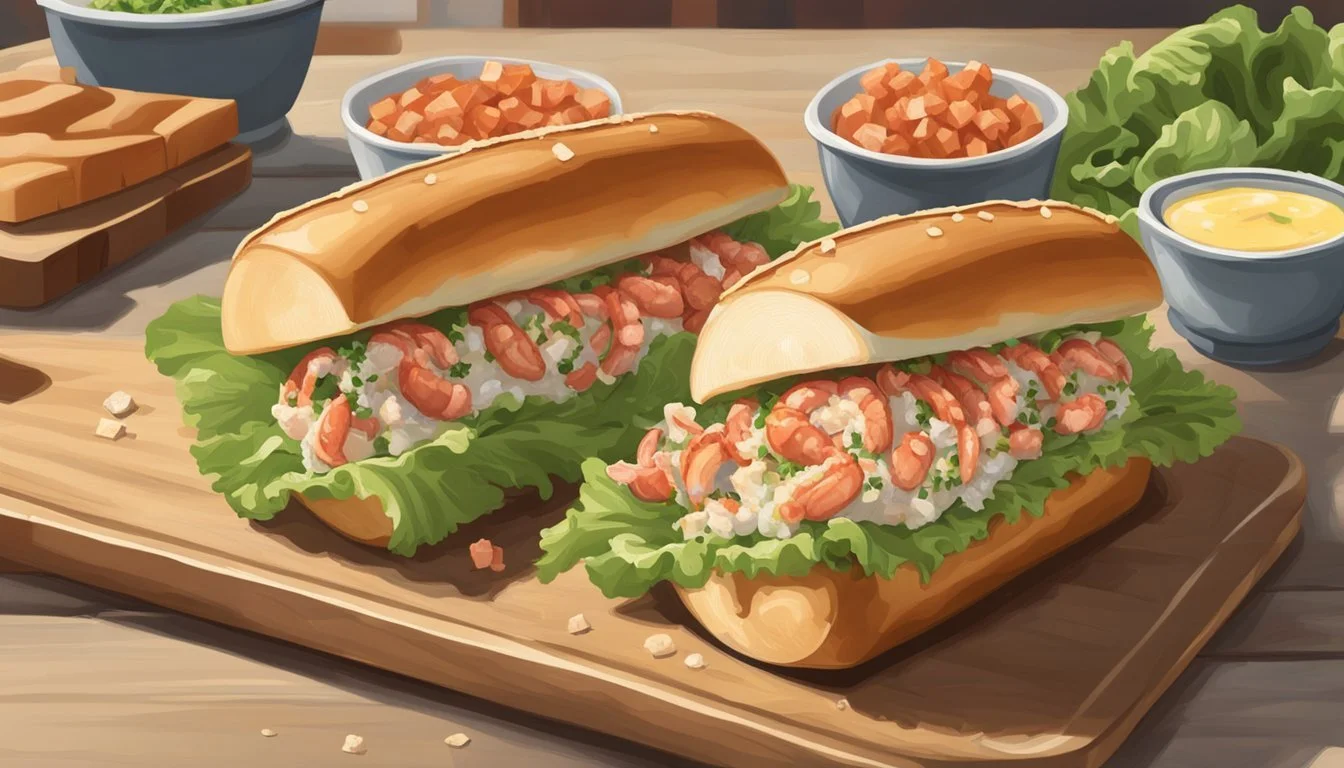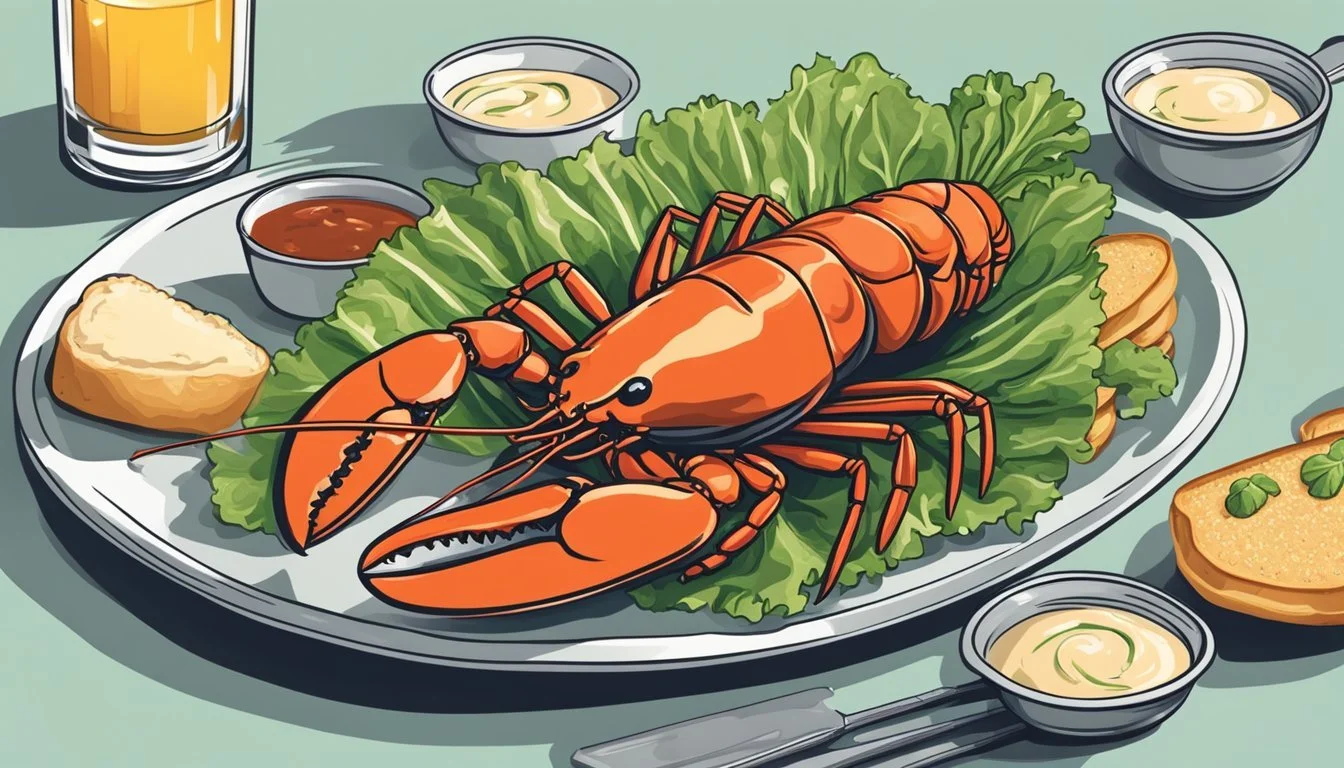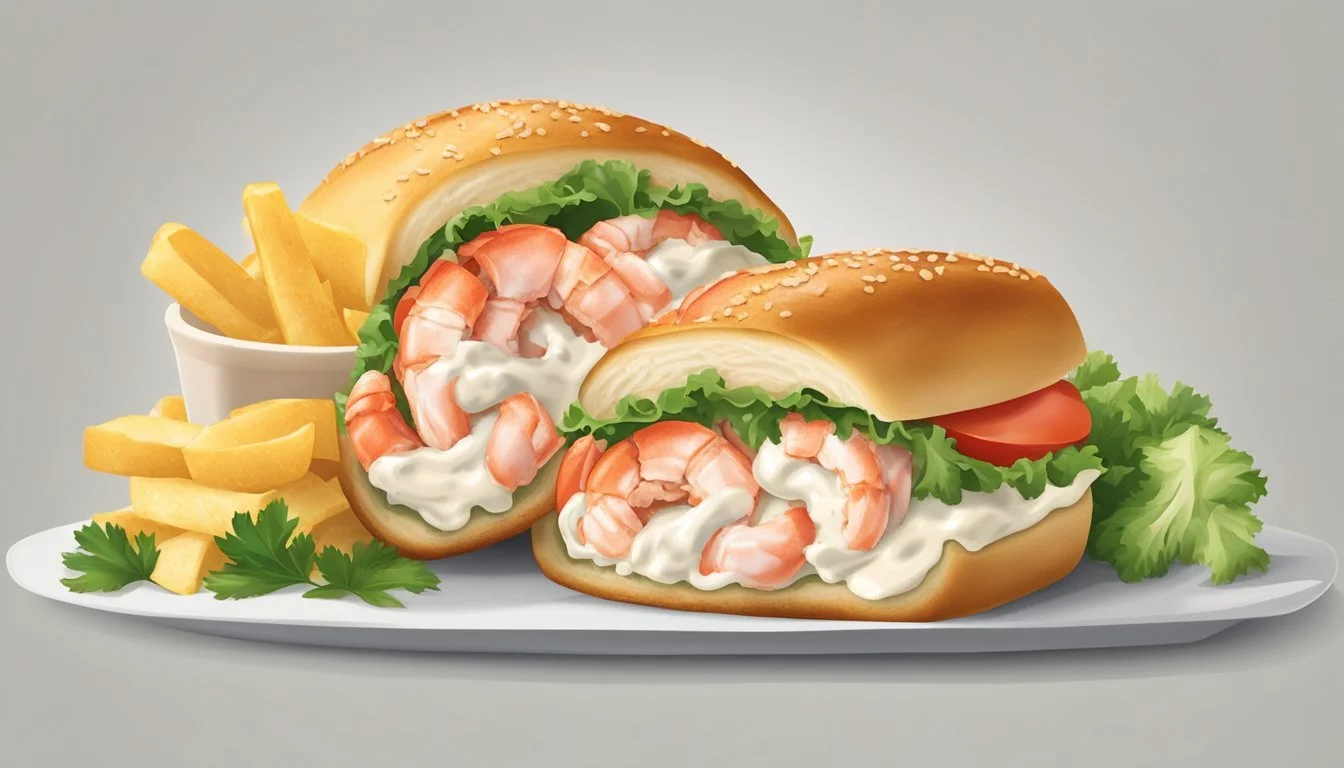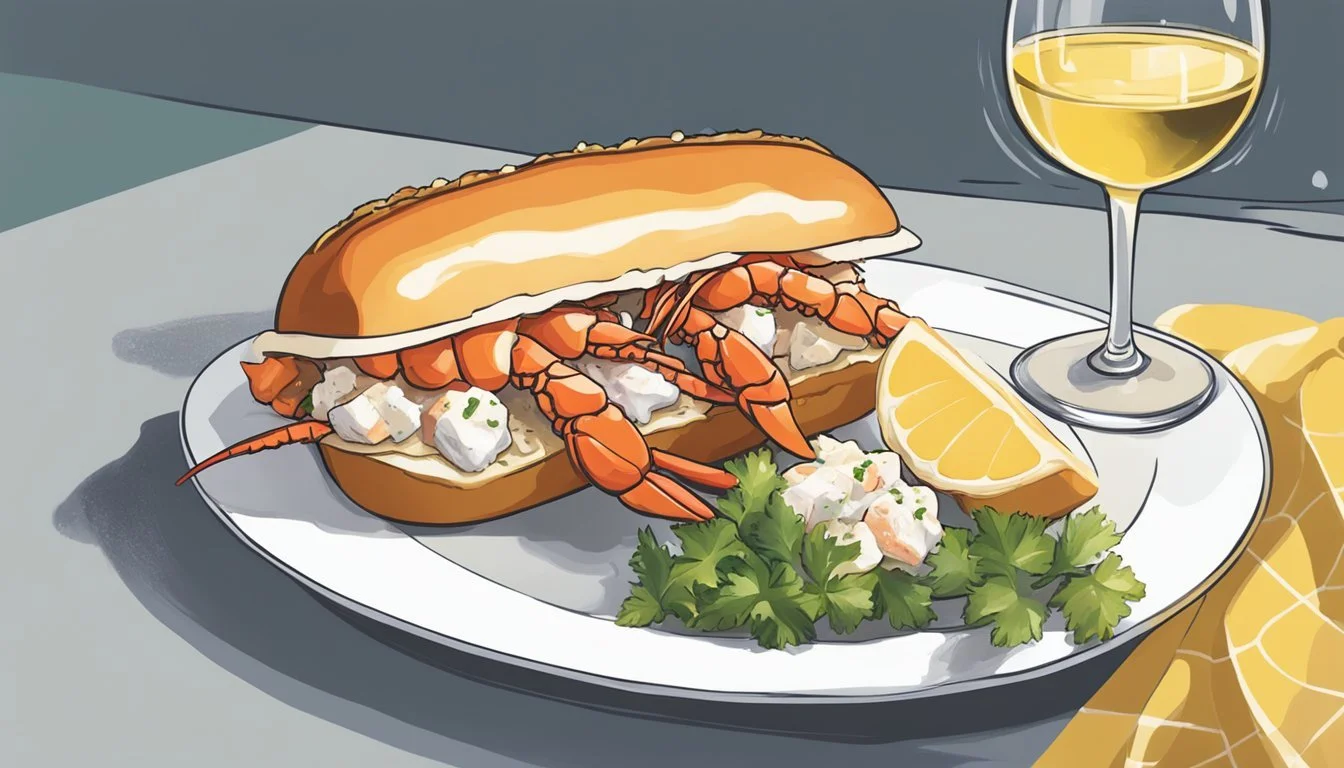How Do You Eat a Lobster Roll?
Tips for Enjoying This Seafood Delight
A lobster (What wine goes well with lobster?) roll is a summertime delicacy that encapsulates the essence of coastal cuisine, particularly in regions like Maine where the lobster industry thrives. This classic sandwich typically consists of a soft, toasted bun filled with chunks of succulent lobster meat. The preparation of the lobster filling varies, but the goal remains the same: to highlight the lobster’s natural sweetness and tender texture.
In crafting the perfect Maine lobster roll, a delicate balance is struck between the rich taste of seafood and the accompanying condiments. Mayonnaise is commonly used to lightly coat the lobster, lending a creamy texture that binds the meat without overpowering it. Some variations also include a touch of butter (how long does butter last?) for a hint of richness, along with subtle additions like lemon juice, celery (how long does celery last?), chives (how long do chives last?), and seasoning to enhance the overall flavor profile.
When it comes to eating a lobster roll, no particular etiquette is mandated, but savoring each bite to appreciate the interplay of flavors and textures is encouraged. Whether one prefers a lobster roll dressed in mayo or butter, served warm or chilled, this dish remains a timeless summertime favorite symbolizing the simple pleasures of seaside dining.
Understanding Lobster Rolls
Lobster rolls are more than just a sandwich; they are a New England culinary icon with distinct regional variations. Knowing these differences is essential for any lobster roll enthusiast.
Overview of Lobster Rolls
Lobster rolls, a New England specialty, have captured the palates of seafood (What wine goes well with seafood?) lovers across the United States. They usually consist of lobster meat served in a grilled hot dog-style bun with various dressings. The historic background of lobster rolls is rooted in New England's fishing communities, evolving from a practical meal for fishermen into a beloved regional dish. Traditionally, lobster rolls are made with Maine lobster, valued for its sweet meat, but the style of preparation varies between regions.
Distinct Styles: Maine vs Connecticut
Maine-Style:
Key Ingredients: Chilled lobster meat, mayonnaise.
Bread: (how long does bread last?) Toasted New England hot dog bun.
Preparation: Lightly dressed with mayonnaise.
Serving: Often accompanied by a side of coleslaw or fries.
Connecticut-Style:
Key Ingredients: Warm lobster meat, melted butter.
Bread: Toasted New England hot dog bun.
Preparation: Tossed in melted butter.
Serving: Typically served with a lemon wedge; sides may vary.
The Maine-style lobster roll is a mayonnaise-based version, where lobster meat is mixed with mayonnaise, and sometimes celery or herbs, and then served cold. In contrast, Connecticut-style lobster rolls are served warm with the lobster meat being tossed in butter. Both styles offer an authentic taste of New England cuisine, yet they cater to different flavor preferences, celebrating the versatility of the Maine lobster in regional culinary traditions.
Selecting Ingredients
Crafting a delicious lobster roll begins by sourcing high-quality ingredients that complement the delicate flavors and textures of the lobster. Each component, from the lobster itself to the bread and seasonings, plays a critical role in creating a harmonious dish.
Choosing the Right Lobster
The core of a lobster roll is the lobster meat itself. For fresh lobster, one should aim for quality fresh seafood to ensure optimal flavor and texture. Live lobsters are the freshest option, but freshly cooked lobster meat or high-quality frozen lobster can also be used. When preparing lobster meat, one must strive to create the perfect soft yet firm texture that complements the other ingredients.
Bread Selection & Preparation
The bread is a vessel that carries the lobster and should be chosen carefully. Hot dog buns or split-top hot dog buns are traditional. The bun must be toasted to a light golden brown to provide a satisfying crunch and warmth that supports the succulent lobster meat. A toasted bun brushed with a little butter offers a rich flavor that can elevate the entire dish.
Additional Ingredients & Seasonings
A well-composed lobster roll contains a balance of flavors and textures enhanced by additional ingredients and seasonings:
Mayonnaise: Use sparingly to bind the meat without overpowering the lobster's natural sweetness.
Butter: Adds a hint of richness; melted and drizzled over the lobster meat.
Celery: Chopped for a subtle crunch.
Seasonings: Including fresh chives, lemon juice for brightness, salt and black pepper or kosher salt for seasoning, and optionally tarragon for a more complex flavor.
Each seasoning should be used thoughtfully to highlight the taste of the lobster, not to mask it. One's goal in this step is to achieve a well-balanced seasoning blend that enhances but does not dominate the primary flavor.
How to Eat a Lobster Roll
Eating a lobster roll is a gourmet experience that balances the texture and flavor of lobster salad with the simplicity of bread. It's a dish best enjoyed by employing proper techniques and pairing it with complementary sides and beverages.
Proper Techniques and Etiquette
When indulging in a lobster roll, one should approach it with both appreciation for the delicate meat and an understanding of casual etiquette. The lobster salad, which should feature chunks of lobster coated with just enough mayonnaise to bind, is typically served in a buttered and toasted bun that provides a satisfying crunch. No lobster cracker is needed; instead, the roll is eaten with hands, much like a sandwich. One must be careful to ensure that each bite includes both the succulent lobster and the bun for the full flavor experience. Using too much sauce, such as mayonnaise, can be seen as a culinary sin, as it may overpower the natural sweetness of the lobster.
One is encouraged to consume the roll thoughtfully—savoring each bite without rushing—allowing for the appreciation of the varying textures from the tender meat to the crisp bun. Lettuce may act as a garnish, adding a fresh crunch without distracting from the main ingredients.
Accompanying Sides and Pairings
The lobster roll calls for sides that complement rather than compete with its flavors. Traditional sides include:
Potato chips or fries: Their salty crispness contrasts nicely with the richness of the lobster.
Corn on the cob: Provides a juicy and sweet flavor profile that harmonizes with the lobster.
Vegetables: A light salad or steamed greens can balance the indulgence of the roll.
As for beverages, a glass of wine or a pint of beer can greatly enhance the dining experience. A crisp, cold beer cuts through the lobster's richness, while a glass of white wine, such as Chardonnay or Sauvignon Blanc, complements the seafood with its acidity and may enhance the lobster's sweetness.
Making a Lobster Roll at Home
Creating a lobster roll at home offers a delightful opportunity to savor New England's renowned seafood treat. Key components of the perfect homemade lobster roll involve using fresh, succulent lobster meat and achieving the right balance in your mayo mixture for a flavorful, yet not overpowering, accompaniment to the delicate taste of lobster.
Step-by-Step Recipe
Gather Ingredients: For a standard recipe, one needs about 8 ounces of fresh lobster meat, 2 tablespoons of mayonnaise, a dash of lemon juice, finely chopped celery, and salt and pepper for seasoning. Fresh chives or parsley can be added for an aromatic touch.
Prepare the Mayo Mixture: In a bowl, combine mayonnaise, a tablespoon of lemon juice, two tablespoons of finely chopped celery, a pinch of salt and pepper to taste, and optionally, fresh herbs. Mix until homogenous, ensuring not to overdo the mayo to avoid masking the lobster's flavor.
Assemble the Roll: Split a top-loading bun and lightly butter each side. Toast until golden brown. Toss the lobster meat gently with the mayo mixture. Spoon the combined lobster and mayo mixture into the toasted bun. Serve immediately.
Cooking the Lobster
Choosing Your Lobster: For authentic flavor, one should opt for Maine lobster due to its sweet taste. Fresh lobster is preferable, but high-quality frozen lobster can be a suitable alternative.
Cooking Fresh Lobster:
Boiling: Fill a large pot with water and bring it to a rolling boil. Add a tablespoon of salt for each quart of water. Place the live lobsters in the pot headfirst and cover. A good rule of thumb is to boil for about 7 minutes per pound of lobster.
Steaming: Pour about two inches of water into a pot and bring to a boil. Insert a steaming rack holding the lobsters and cover. Steam for about 9 minutes per pound.
Preparing Lobster Tails: If lobster tails are more accessible, one can steam or boil them until the shell turns bright red and the meat is opaque, usually about 1 minute per ounce.
Handling Cooked Lobster: After cooking, place lobsters in ice water to stop the cooking process. When cooled, extract the meat from the shell, ensuring to remove any cartilage from the claws or tails.
This section gives guidance on assembling a homemade lobster roll, breaking down the process into manageable steps for both seasoned and rookie chefs to follow.
Serving Lobster Rolls
The perfect lobster roll is as much about the presentation as it is about the taste. Serving this coastal delicacy involves choosing the right plating and garnishing elements that complement but don’t overpower the flavors of the lobster.
Presentation Tips
When presenting lobster rolls, simplicity is key. A classic plating method is to place the lobster roll onto a plate lined with a lettuce leaf for a pop of color and freshness. It’s common to see the rolls served in a grilled and split-top bun, lightly browned for added texture and flavor. The choice of garnishing should be minimal; a sprinkle of finely chopped chives or a light drizzle of melted butter can enhance both the gourmet appeal and the taste without being too heavy.
Color contrast: Utilize a white plate to make the lobster's vibrant color stand out.
Garnishing: A simple sprig of dill or parsley can add visual interest.
Heat: Ensure the lobster is gently warmed, never too hot, which can affect the bun’s texture.
Ideal Serveware
For fine dining establishments or at-home gourmet experiences, metallic or ceramic serveware elevate the dish’s status. A pristine white platter underscores the luxurious nature of the lobster, while small ramekins can hold accompaniments like melted butter for dipping. Serving lobster rolls with sides, such as potato chips or mashed potatoes, adds balance to the meal but should be kept proportionate to not overshadow the main event.
Plates: Opt for large enough plates to accommodate the roll and any sides without overcrowding.
Accompaniments: Provide small bowls or dipping containers for extra dressings or melted butter.
Pairing Drinks with Lobster Rolls
Choosing the right drink to accompany a lobster roll enhances the dining experience, complementing the sweet and succulent flavors typical of this New England favorite. Whether one prefers the effervescence of a crisp beer or the smooth savor of a fine wine, there are myriad pairing options to elevate a Maine lobster roll.
Alcoholic Complements
Within the world of alcoholic beverages, there are specific beers and wines that align beautifully with the delicate taste of lobster rolls:
Beer: A light, refreshing lager or a Belgian-style wheat beer can be an ideal pairing. The carbonation and clean flavors help to cut through the richness of the lobster, providing a palate-cleansing effect.
Type Description Red Claw Lager Light at 4% ABV, offers a crisp, clean complement Witbier Belgian-style, introduces a subtle acid zing
Wine: A dry rosé or a white wine, especially those with citrus undertones, support the lobster's natural flavors without overwhelming them.
Variety Description Dry Rosé Offers soft notes that marry well with sweet lobster meat Citrusy Whites Include lemony accents to enhance the lighter fare
Non-Alcoholic Beverages
For those opting against alcohol, certain non-alcoholic drinks offer a refreshing twist:
Refreshing options that can cleanse the palate and provide a contrast to the creamy texture of a Maine lobster roll are key. Beverages like sparkling water with a squeeze of fresh lemon juice offer simplicity and brightness.
Non-Alcoholic Drinks:
Sparkling water with lemon
Iced tea with a hint of lemon
The carefully selected beverages should resonate with the summer vibe, ensuring a delightful gastronomic harmony with every bite of the lobster roll.
Lobster Roll Variations
The classic lobster roll has inspired numerous variations that cater to different regional tastes and dietary preferences. From international twists to vegetarian adaptations, these variations expand the classic dish’s appeal.
International Takes on the Classic
In search of global flavors, chefs around the world have adapted the classic lobster roll recipe to create unique takes on this New England favorite. For example, some may infuse Asian flavors by adding ingredients like wasabi or pickled ginger. On the other side of the Atlantic, a European interpretation might include a touch of truffle oil or fresh tarragon. These international variations often maintain the sweet flavor of the lobster while introducing complementary flavors that resonate with the local palate.
Connecticut-style lobster rolls serve as a prime example of regional adaptation; these are typically made with lobsters tossed in butter rather than mayonnaise and served warm.
Vegetarian and Alternative Options
For those who don't eat seafood or are looking for a lighter option, the vegetarian lobster roll is a creative and increasingly popular alternative. Vegetarian versions might use mock seafood made from plant-based ingredients like soy protein or hearts of palm to replicate the texture of lobster meat. The same care is given to these alternatives to ensure they carry a sweet flavor reminiscent of the original.
Adapting classic recipes to include alternative options doesn't stop with lobster. For instance, lobster mac and cheese and crab (how long does crab last?)cake-style sandwiches offer similar sea-inspired flavors and can be adapted using mock seafood for a vegetarian twist. These alternative lobster roll variations make it possible for more people to enjoy the essence of this coastal staple, regardless of their dietary restrictions.
Preserving and Storing Lobster Rolls
Lobster rolls require proper handling to maintain freshness and prevent spoilage. This section details pragmatic approaches for short-term storage and extending the shelf life of these delicate sandwiches, ensuring they are enjoyed at their best.
Short-Term Storage Solutions
For short-term storage, the key is to keep lobster rolls cold without compromising their texture. Lobster meat is best kept fresh in the refrigerator. Best practices include:
Refrigeration: Store lobster rolls in the refrigerator at 40°F (4°C) for no more than two hours after preparation.
Airtight Containers: Use airtight containers to prevent the rolls from drying out and absorbing other flavors.
Separation: If possible, store the lobster meat and the roll separately. Refrigerate the meat within an airtight container and keep the bread at room temperature to maintain its texture.
Extending the Shelf Life
To extend the shelf life of lobster meat beyond a couple of days, one must turn to freezing techniques, although it is important to note that the quality may diminish compared to fresh lobster meat.
Freezing Lobster Meat:
Preparation: Cooked lobster meat should be cooled completely before freezing.
Packaging: Double-wrap the meat in plastic wrap or aluminum foil, then place it in a freezer bag to minimize freezer burn.
Temperature: Ensure your freezer is set to 0°F (-18°C) for optimal preservation.
Thawing: Thaw frozen lobster meat in the refrigerator overnight; never at room temperature.
Avoiding Spoilage: Freezing the meat as soon as possible after cooking provides the best quality upon thawing. One should consume frozen lobster meat within 2-3 months to enjoy its freshness.
By adhering to these guidelines, the quality and safety of lobster rolls can be effectively managed during storage.
Eating Lobster Rolls Responsibly
When enjoying lobster rolls, responsible consumption involves both sustainable sourcing of seafood and awareness of the meal's nutritional content. These aspects ensure the preservation of marine ecosystems and promote healthy dining practices.
Sustainable Seafood Practices
Maine, a state synonymous with lobster, is at the forefront of sustainable fishing practices. Individuals who consume lobster rolls should support these efforts by:
Choosing vendors that source lobster from Maine: This supports the local industry that follows strict sustainability regulations.
Seeking certification labels: Look for certifications like the Marine Stewardship Council (MSC) on packaging that indicate ethical sourcing.
Asking restaurants about their suppliers: A well-informed consumer can promote sustainable fishing by patronizing eateries that make ethical choices in their seafood supply chains.
Nutritional Considerations
Considering the caloric content and dietary information of a lobster roll is crucial for those mindful of their health. Typically, a lobster roll includes:
Lobster meat: A protein-rich ingredient with low fat and calories.
Mayonnaise or butter: Used to dress the meat, but should be added with caution to avoid excessive calories.
Bun: Often buttered, contributing additional calories.
To summarize in nutritional terms:
Component Consideration Lobster meat High in protein, low in calories Mayonnaise/Butter Use sparingly to control calorie intake Bun Often adds to the calorie count of the meal
An individual interested in educated consumption should balance enjoyment of the dish with these nutritional factors.







